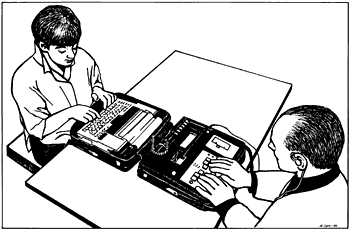Devices used by Deafblind Persons
Deafblind persons with residual hearing and/or vision may use a wide variety of different devices for communication, for getting information as written information, print or braille, for awareness of sounds in their environment, etc. Only a few are described in this text.
Optacon
Optacon If provides access to the printed word and to electronic information via its RS-232 serial interface. As before the device has three components: a small hand held camera (1) that "sees" the print and sends the information to the control unit (2). The control unit processes the information and gives a tactile array (3). The tactile array consists of 100 vibrating rods.
The deafblind person moves the camera across the line and perceives the vibrating image with the index finger of the other hand.
Videomagnifiers
Videomagnifiers or closed circuit television systems, CCTVs are expensive but useful magnifying devices when optical magnification is ineffective. If the patient has lost visual function in low contrast domain, CCTV is the only device that can improve the contrast of the reading material. Most often the patient then prefers a reversal image, white print on black background.
Magnifying systems for screens
There are numerous different modifications to computers to enlarge the text on the screen for visually impaired users. The work can be further supported by voice for those persons who can benefit from auditory information.
Communication devices
In addition to the numerous communication devices in the book "A complete Guide to Communication with Deafblind Persons" there is a new Finnish device "Dialogos" (Figure 8) for deafblind people. It consists of a braille console, an electronic typewriter and a tape recorder.

Figure 8. "Dialogos" enables a deafblind person to communicate with other persons using either typing or Braille. Braille information is received by placing hands on the dark keys that have a pin in the middle of each key. The pins pop up and therefore require much less tactile sensitivity than regular braille print. "Dialogos" can be used as a telecommunication aid as well.
Interpreting during the demonstration and training of these devices is very difficult if the interpreter has no previous experience with their use. The interpreter should always have an opportunity to experiment with the device for a while before trying to convey the often very technical explanations.